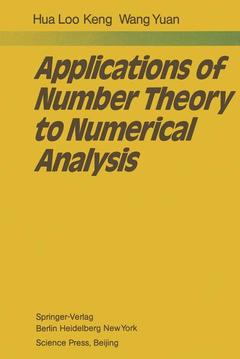Applications of Number Theory to Numerical Analysis, Softcover reprint of the original 1st ed. 1981
Langue : Anglais
Auteurs : Hua L.-K., Wang Y.

Owing to the developments and applications of computer science, ma thematicians began to take a serious interest in the applications of number theory to numerical analysis about twenty years ago. The progress achieved has been both important practically as well as satisfactory from the theoretical view point. It'or example, from the seventeenth century till now, a great deal of effort was made in developing methods for approximating single integrals and there were only a few works on multiple quadrature until the 1950's. But in the past twenty years, a number of new methods have been devised of which the number theoretic method is an effective one. The number theoretic method may be described as follows. We use num ber theory to construct a sequence of uniformly distributed sets in the s dimensional unit cube G , where s ~ 2. Then we use the sequence to s reduce a difficult analytic problem to an arithmetic problem which may be calculated by computer. For example, we may use the arithmetic mean of the values of integrand in a given uniformly distributed set of G to ap s proximate the definite integral over G such that the principal order of the s error term is shown to be of the best possible kind, if the integrand satis fies certain conditions.
1. Algebraic Number Fields and Rational Approximation.- §1.1. The units of algebraic number fields.- §1.2. The simultaneous Biophantine approximation of an integral basis.- §1.3. The real eyelotomie field.- §1.4. The units of a eyelotomie field.- §1.5. Continuation.- §1.6. The Drriehlet field.- §1.7. The cubic field.- Notes.- 2. Recurrence Relations and Rational Approximation.- §2.1. The recurrence formula for the elementary symmetric fonction.- §2.2. The generalization of Sn.- §2.3. PV numbers.- § 2.4. The roots of the equation F(x) = 0.- §2.5. The roots of the equation G(x) = 0.- §2.6. The roots of the equation E(x) = 0.- §2.7. The irreducibility of a polynomial.- §2.8. The rational approximations of ?, ?, ?.- Notes.- 3. Uniform Distribution.- §3.1. Uniform distribution.- §3.2. Vinogradov’s lemma.- §3.3. The exponential sum and the discrepancy.- §3.4. The number of solutions to the congruence.- §3.5. The solutions of the congruence and the discrepancy.- §3.6. The partial summation formula.- §3.7. The comparison of discrepancies.- §3.8. Eational approximation and the solutions of the congruence.- §3.9. The rational approximation and the discrepancy.- §3.10. The lower estimate of discrepancy.- Notes.- 4. Estimation of Discrepancy.- §4.1. The set of equi-distribution.- §4.2. The Halton theorem.- §4.3. The p set.- §4.4. The gp set.- §4.5. The eonstruetion of good points.- §4.6. The ?s set.- §4.7. The ? set.- §4.8. The ease s = 2.- §4.9. The glp set.- Notes.- 5. Uniform Distribution and Numerical Integration.- §5.1. The function of bounded variation.- §5.2. Uniform distribution and numerical integration.- §5.3. The lower estimation for the error term of quadrature formula.- §5.4. The quadrature formulas.- Notes.- 6. Periodic Functions.- §6.1. The classes of functions.- §6.2. Several lemmas.- §6.3. The relations between Hs?(C), Qs?(C) and Es?(C).- §6.4. Periodic functions.- § 6.5. Continuation.- Notes.- 7. Numerical Integration of Periodic Functions.- §7.1. The set of equi-distribution and numerical integration.- §7.2. The p set and numerical integration.- §7.3. The gp set and numerical integration.- §7.4. The lower estimation of the error term for the quadrature formula.- §7.5. The solutions of congruences and numerical integration.- §7.6. The glp set and numerical integration.- §7.7. The Sarygin theorem.- §7.8. The mean error of the quadrature formula.- §7.9. Continuation.- Notes.- 8. Numerical Error for Quadrature Formula.- §8.1. The numerical error.- §8.2. The comparison of good points.- §8.3. The computation of the ? set.- §8.4. The computation of the ?s set.- §8.5. Examples of other F s sets.- §8.6. The computation of a glp set.- §8.7. Several remarks.- §8.8. Tables.- § 8.9. Some examples.- Notes.- 9. Interpolation.- §9.1. Introduction.- §9.2. The set of equi-distribution and interpolation.- §9.3. Several lemmas.- §9.4. The approximate formula of the function of E?s(C).- §9.5. The approximate formula of the function of Q?s(C).- §9.6. The Bernoulli polynomial and the approximate polynomial.- §9.7. The ? results.- Notes.- 10. Approximate Solution of Integral Equations and Differential Equations.- §10.1. Several lemmas.- § 10.2. The approximate solution of the Fredholm integral equation of second type.- § 10.3. The approximate solution of the Volterra integral equation of second type.- §10.4. The eigenvalue and eigenfunction of the Fredholm equation.- § 10.5. The Cauehy problem of the partial differential equation of the parabolic type.- § 10.6. The Diriehlet problem of the partial differential equation of the elliptic type.- § 10.7. Several remarks.- Notes.- Appendix Tables.
Date de parution : 11-2011
Ouvrage de 244 p.
17x24.4 cm
Disponible chez l'éditeur (délai d'approvisionnement : 15 jours).
Prix indicatif 52,74 €
Ajouter au panierThème d’Applications of Number Theory to Numerical Analysis :
Mots-clés :
Applications; Numerische Mathematik; Zahlentheorie; calculus; computer; number theory; numerical analysis
© 2024 LAVOISIER S.A.S.
